
AMERICAN MILITARY KEYS: ( 1910 - Present )
The earliest American military keys were the lovely Civil War camelback keys described in earlier sections. Land-line telegraph communications continued through WW-II using the field sets described in the first section below. By the time World War I began, Spark Transmitters and then radio transmitters were being used and the military added a line of keys designed for these new forms of communication.

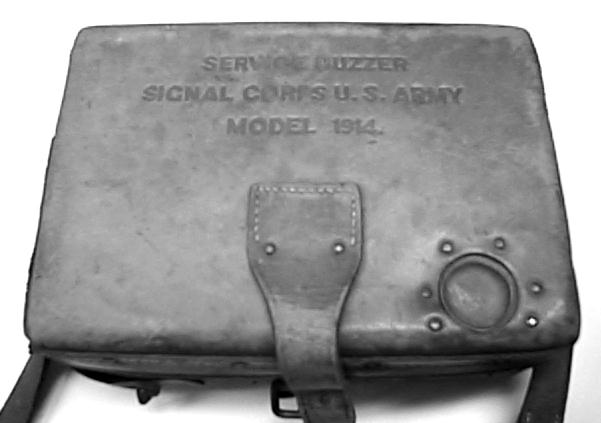
Land Line Field Telegraph Sets: (1918 - 1945 )
The U.S. Army WW-I Service Buzzer Model 1914:
The military continued to use land-line telegraph sets well into modern times and manufactured them in huge quantities. One of the most interesting and frequently seen of these sets is the U.S. Army WW-I Service Buzzer Model 1914 manufactured by Stromberg Carlson and other companies. It is enclosed in a leather case with a thin leather diaphragm that allows the key to be operated with the case closed presumably to keep out the mud of the European trenches. It has an interesting and very tiny telegraph key, a compartment for batteries, and space for a pair of headphones. [606]

WW-I Kellogg Telegraph/Telephone Set:
WW-I vintage with wood case, crank ringer magneto, battery compartment, tiny telegraph key, and telephone. [608]
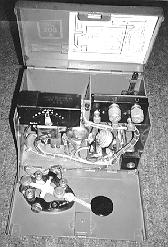
TG5A WW-II Field Telegraph Set:
Metal box with battery and headphone compartments, buzzer, bell, and J-41A telegraph key which has both normally-open and normally-closed contacts. A tremendous number of these sets were made but they are becoming harder to find since many people removed the keys and discarded the sets. [610]
AMERICAN MILITARY SPARK KEYS:
( These Spark Keys have been discussed in the "Spark Keys" section. )
AMERICAN MILITARY RADIO KEYS:
J-Series Keys: The U.S. Army made keys with model designations from J-1 to J-51. Larry Nutting’s book (see Bibliography) describes these keys in detail and an excerpt from his book is included in this book with his permission.
The following J-Series Keys include the ones that you are most likely to find.
THE J-SERIES KEYS:
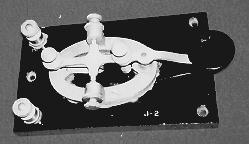
J-2:
The J-2 is an oval based key mounted on a black bakelite base. It was used for keying WW-I radio sets. It is very easy to mistake it for a common WW-II J-38 or J-37. Look for the J-2 model number. Hard to find. [620]

J-3 WW-I Folding-Lever Key:
This key had a folding European / British-style straight lever with the classic tension or pull-down spring. It was manufactured with screw terminals. Another version had Fahnstock clip terminals. It was used inside a field telegraph set and the folding lever allowed the top of the set to be closed. [622] (The key on the left has a homemade swivel portion of the lever. This, of course, reduces it’s value by about 50%.)

J-4 Silenced Instrument Key:
This s a very unusual key. The contacts and adjusting screws have rubber bumpers which reduce the clicking sounds as the key is operated. It was probably used as a practice key and the clicks were eliminated to avoid bothering nearby students in a large classroom. It has the classic European style straight lever and pull-down spring. [624] (W2PM collection)
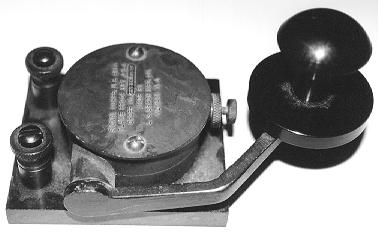
J-5 and J-5A Flameproof Aircraft Keys: ( 1918 - 1945 )
These keys were made in large quantities from 1918 through 1945. The contacts are totally enclosed to allow them to be used in explosive environments without danger of the contact sparks igniting an explosion. [626]
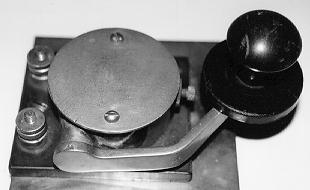
CAG-1169 WW-I Version of the J5 Aircraft key:
This is a flameproof key designed to be used in aircraft. It was manufactured by General Radio Corp. and carried the model number: CAG-1169. [626a]
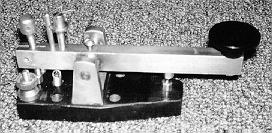
J-6 WW-I Aircraft Key:
This is an unusual key with a classic European style straight lever and pull-down spring.. The base has a distinctive taper. It was manufactured by L. S. Brach in Newark, NJ. and used in WW-I aircraft. [628]
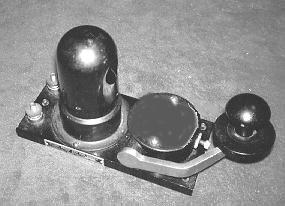
J-7 and J-7A Aircraft Keys with Winker Lamps.
These interesting keys consisted of a J-5 or J-5A key mounted on a black base with a "Winker Light" aimed back at the operator. The purpose of the light is not clear and many explanations have been suggested. [630]

J-12 Radiotelegraph Key:
This key consists of an oval "Triumph Style" key mounted on a 3-1/2 x 2-1/2" metal base. It was used with numerous WW-II transmitters. [632] (See summary of Larry Nutting’s book on page 81.)
J-36 Semi Automatic Keys: (Not Shown in this Section.)
You will find pictures and descriptions of the various versions of this key in the section on semi-automatic keys or bugs. (See [230, 232, and 234]on page 24. )

J-37 General Purpose Key:
This Phenolic oval based key was very widely used in many different applications. It was made by at least 5 manufacturers and mounted on several different bases. They are VERY common. [634]

J-38 General Purpose Key:
The J-38 is a general purpose radio key that was made in very large quantities during WW-II. After the end of the war, I remember huge barrels filled with them for sale at 25 cents each or five for a dollar.
It is a "Triumph-style" key mounted on a black bakelite base with extra terminals for a headset. They were made by many manufacturers including Bunnell and the oval bases were either plated brass (left), or plain brass (right). [636]
JF-38 French Version. [636a] (Not Shown)
JJ-38 Japanese Ver. [636b] (For photo see # 896)

The "Lionel" J-38:
The J-38 was also made by the Lionel Electric Company, manufacturers of Lionel Toy Electric Trains. The Lionel version had the name: "Lionel Electric Co." on top of the cast metal key base and the well known:

"L" emblem cast into the bottom of the rounded-corner bakelite sub-base. [638]

J-41 and J-41A Open and Closed Circuit Key:
This is a J-37 key with an extra set of normally-closed contacts. [640] It is used in the TG-5 and TG-5A field telegraph sets. (See # 610)
J-43 Key: (not shown)
This is a J-37 key mounted on a black base with a push button switch. [642]

J-44 Key:
This is a J-37 key mounted on a black base with a switch which shorts out the contacts: [644]

J-45 Clip-On The Leg Key:
This key was clipped onto the operator’s leg for use in aircraft and various other military vehicles. Later, Post WW-II models are stamped KY-116U. [646] A JJ-45 with JJ-37 key both made in Japan with a Japanese label has been found recently.
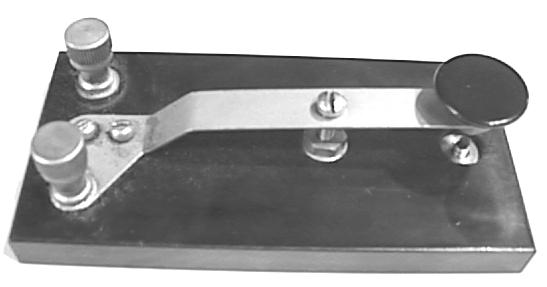
J-46 Signal Lamp Key:
This small strap key was used to key the EE-84 Signal Lamp Sets which were used for sending light signals. They are hard to find. [648]
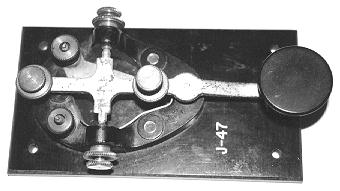
J-47 General Purpose Key:
This is a J-37 key mounted on the same kind of black base as a J-43 and J-44 but without the switch. These keys were used with many WW-II radio sets. [650]

J-48 Enclosed Radio Key:
This olive-drab-painted key was mounted on the
flip-open front panel of the BC-654 portable and mobile radio
set. [652]
This key is in great demand among military
radio collectors because it matches this popular WW-II radio set.

J-51 Scissors-Style Signal Lamp Key:
This unique key was used to operate the SE-11 Signal Lamp. Since enemy soldiers would shoot at signal lamps, the key was supplied with a long cable so the operator could flash the lamp while standing safely far away from the light itself. Black and olive-drab versions were produced. [654]
I am including a representative sampling of the Navy keys that you may expect to find as you search for keys for your collection.
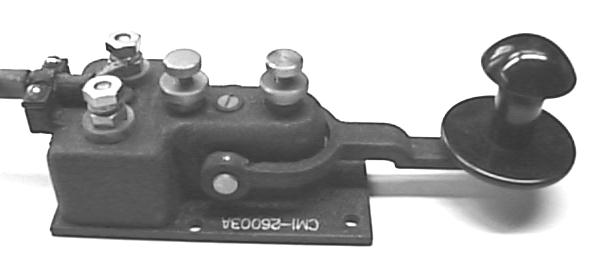
CXX-26003A Flameproof Navy Key:
This is the widely used flameproof Navy key used throughout WW-II. It’s design was apparently copied from the German Luftwaffe Key (818) shown under "German Keys". The three letters at the beginning of the number indicate the manufacturer’s code. This key is a CMI-26003A model. The CMI indicates that it was made by Moulded Insulator Co. [660] Neal McEwen's list of the Navy Codes for different manufacturers is shown later in this book.

CXX-26012A Navy Key:
This is another widely used Navy key used throughout WW-II. It has a small hole on the left side which accepts the "wedge" connector of a J-36 bug. This is a CJB-26012A. (CJB indicates it was made by Bunnell.) [662]
OTHER MILITARY KEYS:

Very Early Flameproof Radio Key:
This key was mounted on the front panel of a WW-I radio set. The contacts were enclosed by a leather membrane so that their sparks would not ignite an explosive environment. [670]
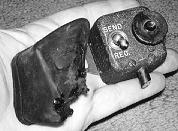
TBY Portable Field Radio Key:
This tiny key was enclosed within the (rather deteriorated) black rubber boot shown on its left. It was used with the TBY radio Set. [672]
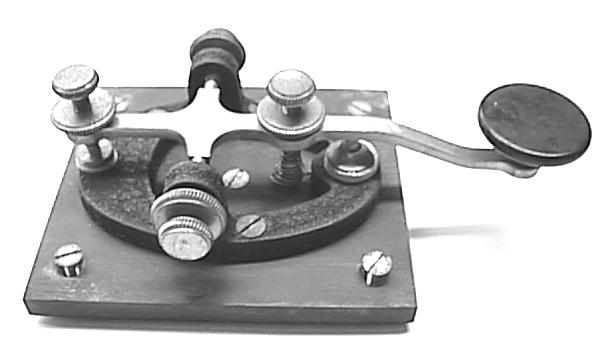
Teletype / Telegraph Test Set Key:
This key is mounted on a black bakelite base which is stenciled: D165581 on the bottom. It was used on a huge test set. Most of these keys were removed from the test set and used by ham radio operators. [674]

VERY Large Navy Flameproof Light Signaling Key:
This huge key was used to send Morse Code with the lights of a ship for visual communications during periods of radio silence. It is encased for use in a potentially explosive atmosphere. It is marked: MIL-C- 24174/3-001 and made by STB Co. with a manufacture date of 1977. [692]

BRELCO Flameproof Key:
This flameproof key is mounted on a circular metal base which clips to the panel of several radio sets and to a thigh-mounted leg clip. The model number starts with CAQZ which shows that it was made by Brelco. [694]

Nylon Strap-on-the-Leg Key:
This recent key is made almost entirely of nylon and held to the operator’s leg by two velcro straps. It is marked KY-605U and it was manufactured by ElectroVoice Corp. in 1976. [696]
Note: Although they were important in WW-II, the next two sets are not very popular among collectors because they are very heavy and bulky and fairly plentiful.

AN / GSC-T1 Training Set:
This set was designed to provide audio code practice tones sent by an instructor and to allow up to 10 students to send code. It consists of a tube-type audio oscillator and amplifier and loudspeaker contained in a heavy metal and wood case. The cover swings upward and stores a total of 10 J-37 Telegraph Keys mounted on special bases which are notched to allow the connecting wire to be wrapped around the key and base for storage. [697] (From the Derek Cohn WB0TUA collection.)
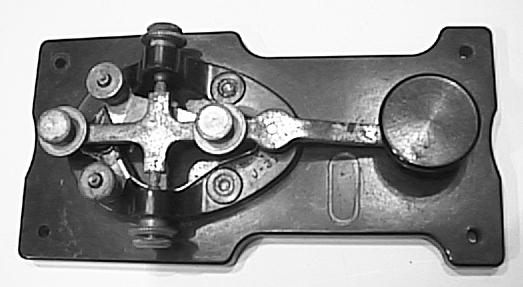
Specially Mounted J-37 Key: (Used in above AN/GSC-T1 practice set)
This J-37 key is mounted on a special plastic base. The base is designed to allow the connecting wire to be wrapped around the key and base so that they both can be stored in the cover of the above AN/GSC-T1 Training set. [697a]

TG-34 Telegraph Training Machine:
This set was designed to automatically send audio tone dot and dash signals at varying speeds for students to practice copying by hand or on a typewriter. A variable speed electric motor pulled a paper tape past a photoelectric tube. A light shined through to the photoelectric tube unless it was blocked by black ink marks on the tape. This determined when the oscillator would be keyed to make the tones. (From the Derek Cohn WB0TUA collection.)